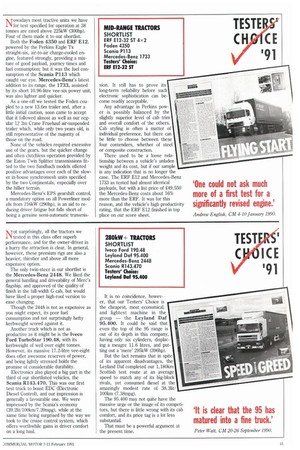MID-RANGE TRACTORS
Page 49

If you've noticed an error in this article please click here to report it so we can fix it.
SHORTLIST ERF E12-32 ST 4/2 Foden 4350 Scania P113 Mercedes-Benz 1733 Testers' Choice:
ERF E12-32 ST
mowadays most tractive units we have IN for test specified for operation at 38 tonnes are rated above 225kW (300hp). Four of them made it to our shortlist.
Both the Foden 4350 and ERF E12, powered by the Perkins Eagle Tx straight-six, air-to-air charge-cooled engine, featured strongly, providing a mixture of good payload, journey times and fuel consumption; but it was the fuel consumption of the Scania P113 which caught our eye. Mercedes-Benz's latest addition to its range, the 1733, assisted by its short 10.96-litre vee-six power unit, was also lighter and quicker.
As a one-off we tested the Foden coupled to a new 13.6m trailer and, after a little initial caution, soon came to accept that it followed almost as well as our regular 12 2m Crane Fruehauf air-suspended trailer which, while only two years old, is still representative of the majority of those on the road.
None of the vehicles required excessive use of the gears, but the quicker change and often clutchless operation provided by the Eaton Twin Splitter transmissions fitted to the two Sandbach models offered positive advantages over each of the slower in-house synchromesh units specified by the two Continentals, especially over the hillier terrain.
Mercedes-Benz's EPS gearshift control, a mandatory option on all Powerliner models from 216kW (290hp), is an aid to reducing driver fatigue but falls short of being a genuine semi-automatic transmis sion. It still has to prove its long-term reliability before such electronic sophistication can become readily acceptable.
Any advantage in Perkins power is possibly balanced by the slightly superior level of cab trim and overall comfort of the others. Cab styling is often a matter of individual preference, but there can be little to choose between these four contenders, whether of steel or composite construction.
There used to be a loose relationship between a vehicle's unladen weight and its cost, but if our sample is any indication that is no longer the case. The ERF E12 and Mercedes-Benz 1733 as tested had almost identical payloads, but with a list price of 249,550 the Mercedes-Benz costs about 16% more than the ERF. It was for this reason, and the vehicle's high productivity rating, that the ERF E12 finished in top place on our score sheet.




















































































































